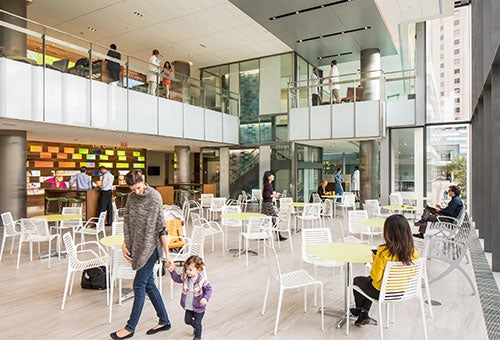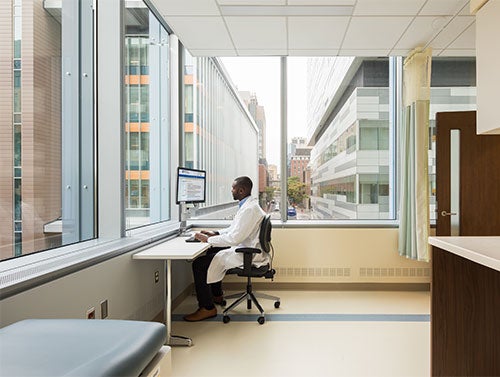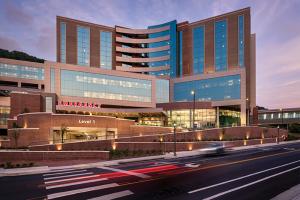Building for Transformative Medicine provides advanced care, research in sustainable facility

The facility features bright, open spaces to promote comfort for patients and families.
The new 11-story, $475 million Building for Transformative Medicine brings state-of-the-art outpatient clinical care and advanced imaging and research to Brigham and Women’s Hospital (BWH) Boston.
The 675,000-square-foot facility will provide care and research in a sustainable facility designed to achieve Leadership in Energy and Environmental Design (LEED) Gold certification.
The building houses eight floors of research laboratories, three floors of clinics for outpatient care, imaging facility, conference and teaching center, and a 400-car underground parking garage. The facility connects to the existing hospital campus via the “Pike,” a quarter-mile-long pedestrian circulation system, which the new building now anchors.
The new facility is designed so that leading clinicians and scientists can collaborate and provide care to patients suffering from neurologic, orthopedic and rheumatologic conditions such as Alzheimer’s disease, Parkinson’s disease and rheumatoid arthritis.
“This is a translational research building, which means that our world-class physicians and researchers can go directly from the lab bench to the clinic and bedside, working together on discoveries and innovations that translate to new treatments for patients,” says Betsy Nabel, president, Brigham and Women’s Health Care.

The building is designed to provide as much access to natural light as possible.
The building features bright, open spaces and amenities that promote the health system’s goal of ensuring that care is delivered in a comfortable space for patients and their families.
The design mission starts with the façade and strategic massing that permits generous amounts of daylight to enter the building and also provides shading when necessary and continues into the two-story light-filled atrium.
A cogeneration plant will provide 80 percent of the power and steam to the facility as well as the adjacent Shapiro Cardiovascular Center. Use of chilled beams reduces energy needs by 20 percent.
A 40,000-gallon cistern that will capture storm water for reuse in the mechanical systems will be installed. The third floor features a rooftop garden accessible from an adjacent conference center.
Other key elements include:
- 383,000 square feet of usable space, including research labs, clinics, infusion suite, imaging floor conference center and faculty offices.
- Five state-of-the-art MRIs, including a Magnetom Terra 7.0 Tesla MRI, the newest and most powerful MRI scanner available and the first in a clinical setting in North America, to be installed within a year.
- The Brigham Innovation Hub that fosters collaboration among leading experts to further enable partnerships within BWH and with industry.
- A centralized infusion suite for patients with any of a wide range of diseases, from musculoskeletal injuries to rheumatoid arthritis.
All clinical teams are scheduled to move into the new facility by the end of this month; all others will be staggered. The building is projected to be fully occupied by March 2017.
“We’re extremely proud to be opening this building, one of the most technologically sophisticated patient care and research facilities in the country,” says Paul Anderson, M.D., chief academic officer and senior vice president of research, BWH.
“The building is designed to provide as much access to natural light as possible, and an open floor plan for collaboration will provide scientists with research spaces that foster creativity, productivity and a robust exchange of ideas,” he says.
Martie Carnie, BWH’s senior patient adviser, was involved in the planning and design of the building from the beginning, sharing insights from the patient and family perspective with building architects.
“To address the needs of patients with cognitive concerns and limited mobility issues, front desks in patient waiting areas were designed for eye-level contact whether patients are standing, sitting in a wheelchair or on a stretcher,” Carnie says.
“Clear signage has been implemented and colors are designed to be calm and soothing. It’s important to know that the patient and family voice was incorporated,” Carnie notes.
The project was delivered utilizing Lean design and construction methods and also building information modeling. Key partners include design firm NBBJ Architects, construction manager Suffolk Construction and mechanical-electrical-plumbing and fire protection engineer BR+A Consulting Engineers Inc.
Want to see your new health care construction project featured on HFM Daily? Email project information and photos to Senior Editor Jeff Ferenc or tweet to him @JeffFerenc.




